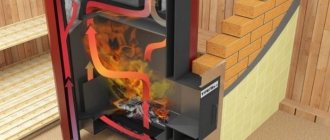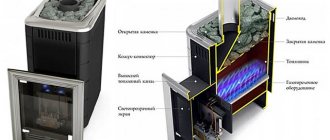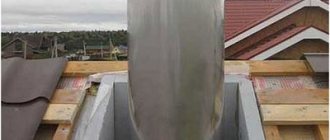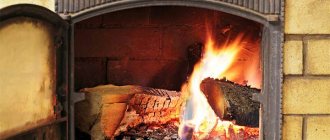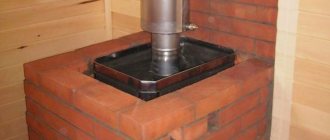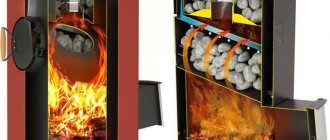In a Russian bath, and not only in it, thick soft steam from tiny particles of water plays a key role along with the correct temperature. And to get such steam, you need stones. And not just any kind, but of a suitable type, without defects and placed in the oven in compliance with the rules.
Although the right stones are important, not every person has the time or desire to understand all the intricacies of their selection and installation. Moreover, there is often conflicting information on the Internet. Therefore, we decided to make a short guide to bath stones, collecting in one place basic information about their properties and use. We hope it will make your choice easier and bring clarity to the questions you were looking for answers to.
Where to get
River stones for a steam room
We already talked about this in the article about how to choose bath stones. However, we can repeat ourselves. There are two main sources: nature and the store. Those who have some experience in identifying unsuitable sedimentary rocks can collect the “harvest” in a field, forest or on the bank of a mountain river. Local residents can tell you where to find suitable stones for a sauna stove, and at the same time show you what they look like.
If you do not have such experience, and the locals themselves buy in the store, then all that remains is to follow their example. In order to prevent dishonest sellers from deceiving you, read the article we have already mentioned or (if you have already figured out what to choose) an article about a specific breed - we usually provide information on methods for checking quality and authenticity. Here are some rocks you can read about here:
- Quartz and crimson quartzite
- Jade
- Porphyrite
- Soapstone chlorite
- Dunit
- Gabbro-diabase
- Nephritis
In addition, there is an article about which stones are better for baths and saunas.
Briefly about the main thing
The main properties of stone for a bath are heat resistance, the ability to store heat and not absorb moisture, density and uniformity of structure.
- Jadeite is an expensive and rare stone that has a healing effect on the human body.
- Soapstone is a northern stone often used for saunas.
- Crimson quartzite is a beautiful brown stone that is resistant to high temperatures and produces high-quality steam.
To lay the heater, you can use gabbro-diabase, white quartz, sea pebbles, and basalt.
You can find some types of bath stones yourself. But you shouldn't do this on a railway embankment.
You need to place stones in the heater, placing them on the bottom. At the bottom there should be the most massive specimens and the most heat-resistant rocks.
It’s not enough to know how to choose stones for a bath; you also need to carefully care for them. Be sure to wash them and periodically replace damaged ones.
Learning to choose and care for stones
Before purchasing minerals for the stove, consider each one carefully. There should be no cracks on them, and the structure should be dense. To test for strength, you can take two elements and hit them against each other. They should not crumble, and the sound will be clear. A more effective method is to hit with a hammer, but this is prohibited in stores.
You can test already purchased elements by heating them to a high temperature and pouring them into a bowl of water. If no cracks appear, then the purchase can be used in a sauna stove, and the heat transfer from them will be uniform.
Do not forget that everything has its own service life, and the heater is constantly exposed to heat. Its contents quickly become unusable. The heat output from the heater drops by 20-30% after a year. It is necessary to take out all the material once a year, inspect and replace damaged material. Whole ones are washed under running water. If possible, it is better to generally change the contents of the heater once a year.
Shape matters
To reduce cracking, it is better to take smooth, rounded stones. In addition to strength, they will transfer heat better and air circulation in the steam rooms will occur faster. Uneven ones with potholes will begin to deteriorate and crack faster when heated.
The size of the heater matters when choosing stones. If you are using a small iron stove, it is better to use a smaller fraction. Massive and heavy specimens are suitable for brick wood stoves.
How to place stones in the oven
It is important not only to choose the size, but also to arrange them in the oven container. It all depends on how the heater is located
Usually the stove heats the heater from below. In this case, the largest fraction is placed at the bottom, a layer of the middle one is placed on top of it, and the smallest ones are placed on top. This way, the grate between the container and the chamber where the fuel burns will close minimally and the stove will warm up faster.
Structure - which is better?
Stones with a layered structure or sand layer cannot be used for baths. It will quickly crumble and clog the holes for air circulation, there will be less steam, and the smoke will be worse to escape.
You can hear the seller recommend using minerals of volcanic origin for the bath. This is a big mistake! They actually heat up faster and retain heat for a long time, but when water is supplied, the fraction splits, throwing small particles into the steam room. They can be harmful to health, so it is not safe to use volcanic stone for a bath! They can only be used with a protective net.
Natural or artificial material?
Specialized departments offer the buyer both artificial and natural materials. Natural is better, it is environmentally friendly and brings healing energy to the bathhouse.
Artificial ones are cheaper and warm up faster, but they do not hold the temperature for long, and their energy is dead. There will be little benefit from such steam.
It is better to buy stones in specialized stores, this is facilitated by a number of factors:
- Not everyone has access to different types of stone and is able to distinguish one from another.
- The optimal fraction for furnaces is selected for sale.
- Before sale, the stones undergo special treatment and foreign microorganisms and viruses will not enter the steam room.
The correct stones for a sauna stove must not only have the required size, density and shape, but also the type. Let's look at the rocks of minerals that have proven themselves in the steam room only from the best side.
Preparation of material
Only large cobblestones are suitable for a closed heater
Not all cobblestones are suitable for a bathhouse. The easiest way to find suitable materials is to go to a specialty store, where they will offer a lot of options to choose from. They are significantly different from stones of natural origin, which not only will not bring benefits, but will also harm your health. The main characteristics by which you need to make a choice are:
The size of the material is very important. It depends on the type of heating device. Small-sized specimens are suitable for electric stoves, but for wood-burning stoves with an open heater, filler of various sizes is suitable - from 6 to 20 cm in diameter.
Is it possible to mix stones for a bath?
The answer to this question is definitely positive. You can mix. Moreover, you are free to lay them out in layers or mix different ones within one layer.
Many of those who have an open fire in the stove or are not able to fill the entire volume with expensive rocks use cheaper ones for the lower layers. Or they do the same for other reasons, for example, as mentioned at the beginning, to speed up heating due to the different thermal conductivity and heat capacity of the rocks. The third reason is purely aesthetic. You can choose colors so that they look beautiful when wet. For example, by mixing green and red specimens. Or red and gray.
How to prepare a stone
- just soak the batch in water without anything for several hours (you don’t have to do this, but this is also a test: watch to see if gas bubbles are released - this is a sign of cracks, specimens with bubbles must be removed);
- then go over each thoroughly with a stiff brush and rinse under running water.
The washed batch can be calcined and thrown into water. If any of them split, they will be rejected.
In the future, the stones will need to be sorted with some regularity. You can do this once a year, every six months, every season. Deterioration in heating quality may be a signal for an unscheduled inspection.
Placing stones in the oven
How to properly place stones in a sauna stove? Almost every buyer asks this question. Along the way, questions arise:
- What is the best way to heat the stone?
- What volume of stone backfill should there be?
- How to prepare the stone?
- How to choose a stone?
- How long should the stone be used?
Let's immediately decide on the volume. The volume of stone filling in the furnace must correspond to the requirement of maintaining the microclimate of the steam bath and the intensity of steaming. If the stove does not have a steam generator, the stone must provide high-quality steaming throughout the entire period, and then it turns out that there must be a lot of stone. But much is a relative concept, since a stone heated to 200*C will produce several times less steam from the same amount of stone heated to 400*C. And this concept suddenly begins to depend on the design of the stove, the selection of its power and the skill of the bath attendant. Many passports provide a standard calculation of stones for a sauna stove, which is tied to the area of a steam room equal to 30 - 50 kg of stone per 1 square meter. However, this is such a primitive selection that it is more suitable for a black sauna. If anyone doesn’t know, the black bathhouse had a fireplace with at least 500 kg of stones, which were heated by an open fire until they glowed crimson. Of course, the stone took a very long time to heat up and it was an unsuccessful decision, but at that time it was practically the only one. A well-heated stone to a crimson glow, of course, had an excellent ability to vaporize. For this reason (the quality of the steam), the black sauna was declared a classic sauna.
And since stones at that time were the only source of steam. Then certain requirements are put forward to them:
- The stones must be resistant to high temperatures.
- The stones must have a good ability to accumulate heat.
- The purity of stones from salts of heavy metals, radioactive elements and any organic and harmful impurities.
- In addition to accumulating heat, the stone also needs to release it quickly.
- Bath stone is also valued for its mechanical strength against sudden cooling after strong heating.
- Since the stone is poured into the equipment, the requirement for the preservation of this equipment is minimal thermal expansion.
- And, of course, the stone should please the eye - beautiful shape and color matter.
Stones are washed in running water before laying. They sort through - rejecting: with cracks, uncharacteristic veins, foreign odors. After this, the largest stone is placed in the heater first. In the gaps and on top, small stones are placed tightly to the surface of the stove and without voids in the heater - the quality of its heating depends on this. The stone should not be placed edge-on to the heated surface, only flat - this will speed up its heating. The stone for open and closed heaters is laid equally tightly. The only difference can be for stones heated by direct fire and hot gases - these stones are laid loosely without small stones so that hot air or flame can move freely between the stones. It must be remembered that it will take more time to heat the stone, wood and time in a closed heater than in an open, ventilated one. This is due to the fact that the stones in a closed stove are heated by the contact method of heat transfer from the walls of the firebox - inside the stone - to the walls of the stone - to the next stone, etc. In a ventilated heater, in addition to the contact method, hot air participates in heating (similar to how a stone placed in a closed heater of a firebox heated by hot gases is heated)
Another very important requirement is how much stone to put on the heater. For example, in a closed heater you cannot put more than the box can hold, but an open heater gives flexibility for the various desires of some to enlarge the heater
The logic of such actions is simple: we need steam - steam produces stone - which means we need more stone - and there will be a lot of steam. But no! The more stone we apply, the less steam we get. There is a steam with which you can steam. The top stone does not heat up and takes on the water, evaporating it gradually and worsening the microclimate of the bathhouse. In such baths it is damp and you can’t breathe. Under no circumstances should the stone be placed higher than the edge of the heater. Nothing will be gained from this. Big piles are arranged by managers in advertising companies. But this is a fake and nothing more. Take the right stone, place it correctly and get the right steam. Watch our videos. If you don't understand, ask on our forum. We will definitely answer. Experts will help you.
Sergey Zavgorodsky from the village of Naumovka, Sterlitamak district, Bashkiria, asks:
I am currently building a bathhouse on my property. Tell me how to lay stones in a sauna stove?
Expert answer:
After completing the installation of a sauna stove, a person faces a dilemma: how to properly lay the stones to achieve the greatest effect?
This process can be divided into three main stages.
Flushing. Before proceeding directly to installation, you should thoroughly wash the stones (even if they visually seem clean) so that the dust that has settled on them does not enter the steam room atmosphere.
Sorting. After washing, you need to sort the stones by their type (smooth - embossed) and size (large - small). This is necessary for the correct chronological sequence of layers.
Laying. It is recommended to stack the stones in order of decreasing size. The bottom layer is large parts (75–140 mm), then medium (50–90 mm) and small. Stones can be laid relative to each other horizontally and vertically. To achieve maximum effect, the material should be in a vertical position, so heated air will pass between them much more freely. A combination of different rocks (quartzite - basalt) is quite possible.
The user should note that from time to time the contents of the heater need to be sorted out or even replaced completely. This must be done when the steam becomes harsh or when the heat in the bathhouse is poorly maintained and the room cools down quickly.
This is interesting: Vibrating screed for laying concrete price 2022
The type of material used is of great importance. It must combine the following qualities:
There are several main types of stones with unique properties for use in the bath:
To increase efficiency, it is recommended to use several types of rocks for laying stones in a sauna stove, which could complement each other. Other rocks can be used as a filler for the heater, provided they contain no toxic substances.
What kind of water to pour on the stones in the bathhouse
The question, by the way, is not an idle one. Understanding when and how much to pour water comes with experience, but you need to know what it should be from the very beginning. The water must be heated.
IMPORTANT! The hotter the water, the smaller the temperature difference for the stones, which means there will be less wear and tear on them, and you won’t have to waste extra firewood. One big benefit! Fill up with hot water in advance and place it near the heater so it doesn’t get cold
Fill up some hot water in advance and place it near the heater so it doesn’t get cold.
You can also prepare the water with various additives, depending on your goal. For example, if you need to treat a cold, then add up to 10 drops of menthol or a teaspoon of dry mustard (per three liters of water) to the drinking water. For the same volume you can pour 50 ml of beer or kvass, or herbal infusion, a tablespoon of ground coffee, and a drop of aromatic oils.
There are many recipes. The main thing is that all these additives do not simply burn out on overheated stones. Therefore, a special place is usually allocated for such a donation. Or, as an option, they simply place a container with pleasant-smelling contents next to the heater.
Gabbro for steam baths
How to properly place stones in a sauna stove
Choosing the right stones for your bath is only half the battle. It is also necessary to prepare them correctly, and then put them in the heater.
After the stones have undergone a thorough external inspection to look for defects and cracks, it is recommended to pre-treat them in a weak salt solution for 1-2 hours.
Before placing stones in the sauna stove, they need to be washed and dried naturally.
After that:
- large specimens are placed in the lower part of the heater;
- then – average;
- y - small, at least 5-6 mm in diameter.
It is also possible to use stones of the same size; in this case, it is preferable that the diameter be in the range from 7-8 to 15 cm.
If the stove is iron and small in size, then you should not use very large samples; it is enough to stay at medium sizes. For electrical products, small stones placed in fairly narrow spaces between the heating elements would be a suitable option.
In some cases, recommendations to use large or medium-sized stones for large wood-burning stoves are rationally justified. In this case, proper heat exchange is ensured. When laying tightly, if small stones are used, this process is somewhat difficult. But not everything is so simple.
In any case, steam and heat will find loopholes to escape, so this point is not so relevant. Especially if you look at the process from the other side. If there are no small stones in the heater, water may get on the metal. In this case, the result is a rather unpleasant, “hard” feeling of steam, sometimes even with a specific metallic taste.
The use of small stones, especially when combined with large specimens, is also supported by an increase in the overall specific heat capacity of the stove. If stones of medium or fine fraction are used, the packing density increases, and this affects the quality of the steam due to the fact that the water rolls down more slowly and reaches the lower, hotter layer, and does not evaporate on the way to it.
The steam is softer and drier. It is based on this principle that one should be guided when the question arises about which stones are best for a sauna, as well as what size they should be. Even taking into account the fact that steam production is not expected in this case.
It is also important to correctly carry out the hardening procedure for masonry. To do this, you need to gradually heat the stones until they turn red in the lower part, then suddenly pour water on them, cold of course.
After waiting for the stones to cool completely, conduct a visual inspection for the appearance of defects and, above all, cracks; if necessary, reject low-quality specimens and replace them with new ones. In the event that more than 30% of the stones have to be shifted, the hardening procedure should be repeated.
Of course, proper placement of stones in a sauna stove ensures better heat transfer and steam formation, but it is important to monitor the quality and purity of the water used for the stones. There must be a hot and clean liquid, even if special aromatic additives are used
This guarantees not only more steam production, but also preserves the stones.
Sergey Zavgorodsky from the village of Naumovka, Sterlitamak district, Bashkiria, asks:
I am currently building a bathhouse on my property. Tell me how to lay stones in a sauna stove?
Expert answer:
After completing the installation of a sauna stove, a person faces a dilemma: how to properly lay the stones to achieve the greatest effect?
This process can be divided into three main stages.
Flushing. Before proceeding directly to installation, you should thoroughly wash the stones (even if they visually seem clean) so that the dust that has settled on them does not enter the steam room atmosphere.
Sorting. After washing, you need to sort the stones by their type (smooth - embossed) and size (large - small). This is necessary for the correct chronological sequence of layers.
Laying. It is recommended to stack the stones in order of decreasing size. The bottom layer is large parts (75–140 mm), then medium (50–90 mm) and small. Stones can be laid relative to each other horizontally and vertically. To achieve maximum effect, the material should be in a vertical position, so heated air will pass between them much more freely. A combination of different rocks (quartzite - basalt) is quite possible.
The user should note that from time to time the contents of the heater need to be sorted out or even replaced completely. This must be done when the steam becomes harsh or when the heat in the bathhouse is poorly maintained and the room cools down quickly.
This is interesting: Ironing on medium hair with volume 2019
The type of material used is of great importance. It must combine the following qualities:
- heat capacity;
- environmental friendliness;
- heat resistance.
There are several main types of stones with unique properties for use in the bath:
- quartzite – the main advantage is the ability to heat up quickly;
- basalt - along with high strength, can retain heat for a long time, thereby maintaining a high temperature in the steam room;
- gabbro-diabase is an inert volcanic rock rich in various minerals and is environmentally safe for human health.
To increase efficiency, it is recommended to use several types of rocks for laying stones in a sauna stove, which could complement each other. Other rocks can be used as a filler for the heater, provided they contain no toxic substances.
Electric heater for a bath selection criteria
In the last century, bathhouses were built for washing. Nowadays, the bathhouse is more of a place for relaxation and healing of the body. If you decide to equip your house or build your own bathhouse on the property, then one of the first questions you will face is which stove to choose. The optimal solution is to buy an electric heater.
Why should you choose an electric heater?
If not electric, but any other energy is chosen for heating, then a number of factors will appear that will need to be taken into account during the design. You will need a separate place for storing fuel, a chimney system, etc. The heating of the bathhouse will take place with mandatory human control and safety. The exception is the use of natural gas and a special automation system. But this heating method is very expensive and is more suitable for commercial baths. In short, the use of non-electric energy to fire a bathhouse is associated with solving many problems. But why complicate your life? When using an electric heater, everything is much simpler. All you need is the availability of electricity and compliance with electrical safety rules.
Determining the required power of the electric heater
As a rule, the steam room in baths is small in size. But a modest area does not guarantee good heating from a low-power electric heater. To select the optimal power, it is necessary to take into account the size of the dressing room and possible heat losses.
The power of electric heaters starts from 2.5 kW. This power is sufficient for a small steam room of 2-2.5 cubic meters. m. In this case, it is worth considering the need for steam circulation. That is, the steam room must have an outlet for hot air. In addition, in the winter season, heating the bath takes longer than in other seasons. That is, the purchase of an electric heater with a power of up to 4 kW will be justified only for a bathhouse inside the house. For baths located on the site, heaters from 6 kW are required.
Installation method
Electric heaters can be installed on the floor or on the wall. When installing on a wall, it is worth considering that the weight of the heater with stones can reach up to 35 kg. Therefore, you need to choose a place for strong mounting on a load-bearing wall. When installed on the floor, it must be taken into account that the weight of the heater with filling can reach 100 kg. Therefore, the place for its installation must be reliable and durable.
The basic rules for installing and placing electric heaters are prescribed in the instructions. But let’s note the most important things to remember:
- The space above the stove should be enough for free circulation of hot air inside the steam room.
- Flammable materials located near the heater are unsafe.
- It is necessary to ensure the safety of people, so the heater must be located at the required distance from the shelves.
In order to prevent burns, some manufacturers produce electric heaters with Fiber coating, which not only reduces the possibility of injury, but also increases the fire hazard. If such a covering is not available, a wooden fence can be installed.
Are stones important?
Proper placement of stones is very important to ensure sufficient heat. Large stones are placed at the bottom, smaller ones at the top. You should not fill the heater too tightly, as this will impede air circulation inside the heater. Optimal placement of stones ensures heat transfer even after the heater has already been unplugged
In addition, when laying it is important to be careful so as not to damage the heating elements and damage the stove.
Where to buy stones? They can be purchased at a specialty store. But the cost of filling the oven will not be very cheap. If it is possible to bring high-quality crushed stone, then this option will be no worse than buying stones.
Which electric heater to choose?
It all depends on what you want to get as a result. If you just need a steam room, then you can get by with a standard model without any frills. For lovers of unusual solutions, the market offers a large number of different options. But when choosing a fashionable stove, it is worth remembering that the price will be very high, and the practicality compared to a conventional model will be only 5 percent greater.
There are many manufacturers of electric heater stoves. But the most reliable are Finnish models. Reputable brands such as Helo, Sawo and Harvia can be found in any specialized retail outlet. We hope that our tips will help you choose a good stove. But despite all the pleasantness and benefits of the steam room, you should not abuse it. Remember that everything is good in moderation.
Unique properties of jadeite stone
This greenish-colored stone is one of the most durable among those used for heaters; it is classified as a semi-precious rock and, accordingly, its price is one of the highest. Due to the fact that it has:
- beautiful appearance;
- high heat capacity;
- low water absorption;
- unique healing properties,
its use in a heater is completely justified. Moreover, in order to reduce costs, it is possible to purchase not a complete set, but only a few stones and lay them on top of the masonry.
The beneficial effects of jadeite stone, especially in a heated state, on the circulatory, endocrine, genitourinary, nervous and other systems of the body have long been known.
It also has a powerful healing effect for joint pain. Bioenergetics specialists consider it a unique stone for restoring the human energy field.
- beneficial infrared radiation;
- air ionization;
- enrichment of water with metasilicic acid.
Its service life is at least 5 years, only after which it gradually begins to lose its effectiveness.
When purchasing jadeite for a steam room, or choosing which stones are better for a heater, you must take into account that for a Russian bath, a split specimen is a suitable option, due to the increased surface area providing a larger amount of steam. Polished stone is more effective in a sauna.
Soapstone: king of saunas
A stone with shades of gray, high strength, the ability to heat up quickly and a large storage capacity. A source of light and pleasant steam. If it is used together with other stones, one should take into account such a feature as dustiness, which can be avoided by thoroughly washing and hardening all samples before placing them in the heater.
The stone is a source of soft “radiant” heat, the radiation wave of which coincides with the length of the thermal wave emanating from the human body.
Its homeland is Finland and Karelia, which explains its popularity in saunas, despite the fact that the cost is quite high.
Raspberry quartzite
When thinking about which stones are best for a sauna stove, you should also pay attention to crimson quartzite, a bright purple-brown color. It is one of the most durable rocks, resistant to cracking - it is not afraid even of cold water, which can be safely poured on the heater.
Has increased heat capacity, low water absorption.
How to build a bathhouse from timber with your own hands? – there is more useful information here.
Its medicinal properties are also known:
- has a beneficial effect on the circulatory system, normalizing blood pressure;
- eliminates joint pain;
- helps with migraines, problems associated with changing weather;
- normalizes the functioning of the reproductive system organs.
But, most importantly, porphyry, as crimson quartzite is otherwise called, produces very light steam for a long time even after the stove stops operating. Therefore, in a bathhouse with such a stone you can enjoy the soft, beneficial warmth for a long time.
You will be interested in this article - How to line the inside of a bathhouse with clapboard with your own hands?
Sources
- https://parilochka.com/pechi-dlya-bani/kamni/ukladka.html
- https://v-banyu.ru/kak-vybrat-kamni-dlya-kamenki-v-banyu.html
- https://parilochka.com/pechi-dlya-bani/kamni
- https://banyabest.ru/pechi-dlya-bani/kak-vybrat-kamni-dlya-bani.html
- https://DimDom.ru/kamni-dlya-bani-kakie-luchshe-vybrat.html
FAQ
Is it necessary to fill all the small cavities inside the Kutkin stove with small pebbles, in which there is a gap of 3 cm between the casing and the body? Or does it only need to be filled in the central part?
The gap is a structural element that ensures proper heat transfer. There is no need to fill it with small stones.
I put the purchased porphyrite in the stove, but for some reason it cracks when fired. Isn't this dangerous?
Porphyrite may crack slightly during the first or second heating - this is normal. But if the crackling sound is heard constantly, the stones should be reconsidered and, if necessary, replaced. Perhaps you received heterogeneous specimens with foreign impurities.
I installed a convection oven in the bathhouse and laid it with stone according to all the rules. But the stones do not heat well, although the temperature in the steam room is high. What's the matter?
Economical convection ovens are much more often used in saunas rather than Russian baths. They were purposefully created in order to reduce the amount of fuel and time to heat the room. That is why short heating leads to maximum heating of the room, and the stones do not have time to warm up. No matter how you arrange them, they will produce weak steam. For a Russian bath you will have to change the stove or install a steam generator.
Stones for electric heater
Gabbro-diabase for steam room in electric heater
An electric stove can be used with equal success in both Russian and Finnish baths
But here you should take into account this nuance:
IMPORTANT! The smaller the volume of the electric heater, the more this model is intended for a sauna. Models capable of operating in the “Russian bath” mode start with 60 kilograms of filler
Models capable of operating in the “Russian bath” mode start with 60 kilograms of filler
IMPORTANT! The smaller the volume of the electric heater, the more this model is intended for a sauna. Models capable of operating in the “Russian bath” mode start with 60 kilograms of filler
The electric heater is sensitive not so much to the types of stones as to their size. If you can put samples measuring 13 cm in a regular one, then no more than 7 cm are suitable for this one. As for their installation, we have a separate detailed article on this topic.
Video description
Here is an interesting video on how to wash bath stones:
In order for the steam room to function properly, it is necessary to correctly calculate the mass of stones. It is believed that there should be 5-6 kg of rock per square meter. Then the desired effect and maximum durability of the heater will be achieved.
Different types of stone differ in their service life
For stoves with a closed heater, a type that is more resistant to high temperatures is needed. In open stoves, the heating is less intense, so deciding which stones are better for the heater in the bathhouse is much easier.
Recommendations for caring for bath stones
In order for stones to last a long time, you need to know how to properly care for them.
- Before using the stones, you need to check if they are cracked, chipped or otherwise damaged. Then the stones are kept in salt water for an hour, washed thoroughly, preferably with a brush, but without the use of chemicals, and allowed to dry at room temperature.
- Experts advise filling the stove-stove in three layers with stones of different sizes, leaving gaps through which steam and air will pass. Moreover, it is necessary to place the largest stones at the bottom (120-150 mm in diameter), and towards the top of the masonry their size should gradually decrease.
- In order for the heater to warm up the steam room well, you should adhere to a ratio of 1:50 in relation to the volume of stones to the total volume of the room. The most optimal size is 70-150 mm in diameter.
- To ensure long service life, stones must be hardened. To do this, they are heated until a red color appears in the lower rows, and then they are sharply doused with cold water. Stones on which cracks appear after this procedure are rejected.
- You should constantly monitor the condition of the stones in the bath. If plaque forms or stones become dirty, they must be washed well and dried in fresh air. Every three to four months, a full inspection of all stones is carried out for the presence of chips, cracks and other defects, after which damaged specimens must be replaced with new ones.
- During bathing procedures, you need to water the stones with strictly hot water, which significantly increases their service life and produces rich, hot steam.
Briefly about the main thing
The main rule for laying stones in a bathhouse is that the largest elements should be placed closest to the heat source, leaving free passages between them for the movement of hot air. As it rises, it will heat up the next layers, composed of a smaller fraction. It is also advisable to take into account the thermal conductivity and heat resistance of stones, laying down the strongest rocks that easily give off heat. Ideally, you should choose the filling for the heater taking into account its design, so that one condition for proper installation does not contradict another.
Source
What should be the stones in the heater?
Minerals for the heater are not only those you like. Even recommended breeds must meet a number of characteristics:
- Eco-friendly and safe for health.
- In terms of mass, the stones should be heavy, the fraction should be medium, too small are not suitable, as are too large. The density is high. This will prevent the minerals from cracking when interacting with water.
- The coefficient of thermal expansion should be the same; in other words, you need to take stones of the same type and approximately the same size: large ones 7–13 cm, small ones — 4–6 cm. This way the heater will heat up evenly.
- Tolerates high temperatures well.
- The surface is homogeneous.
- Classical and ultrabasic rocks should not contain more than 43-54% silica.
These characteristics are not always characteristic of a particular breed. It is better if most of them are suitable for the selected product.
How to choose stones for a bath or sauna
Choosing stones for a bath is a simple and at the same time complex matter. The following physical parameters of the material should be taken into account:
- density, that is, the greater the weight of the stone, the better;
- heat resistance, the ability of a stone to undergo repeated heating/cooling processes without much loss (at least for quite a long time) of its qualities and properties;
- heat capacity, the property of a stone to accumulate and retain heat, with the purpose of subsequent release into the environment. The higher the heat capacity of the material, the longer it retains the ability to maintain the required temperature after the furnace heating process has stopped.
There is a similar article on this topic - Long-burning wood stoves for the home.
Must be:
- environmentally friendly;
- homogeneous in structure. It is not recommended to use stones for a sauna stove with inclusions: this will cause uneven heating, which will lead to their delamination and destruction;
- without cracks: to check this quality, you should knock the stones against each other or hit them with a hammer. A clear sound will indicate the absence of a defect;
- approximately the same size and shape - this will ensure uniform heating, air and steam circulation. Before you find out which stones are best to use in the steam room based on their structure, preference should be given to specimens with a smooth surface, and based on their shape – oval or round.
Although some believe that chipped stones have a larger area of heat reflection and are more effective. This is true, as is the fact that smooth stones are less susceptible to cracking, which means they will last longer.
In addition, using a hammer you can obtain information about the density of the sample. The following experiment will help you learn about the ability to withstand sudden temperature changes: after heating a stone to the highest possible temperature, it should be sharply lowered into a bucket of cold water. The absence of cracks is a guarantee that a particular specimen will last a long time.
Possible mistakes
Incorrect placement of stones in the stove can lead to incorrect circulation of hot air.
Inexperienced sauna lovers may make the following mistakes when laying and choosing material:
- Incorrect number of cobblestones. An insufficient number of elements in the heater will not produce enough steam. And if there is more material than needed for this type of oven, it will not be able to warm up well.
- Incorrectly selected filler and its size. Vapor formation depends on the properties of the components, and the circulation of gases in the space between the cobblestones depends on the size.
Before placing stones in the heater, you should consult a professional. And if you are unsure of your abilities, then it is better to invite a master. After all, correct installation affects the pleasure received from bathing procedures.
What are the best stones for a closed heater in a bathhouse?
Jade for sauna stove in packaging (bucket)
A closed heater is a metal chamber inside a stove, with a door and pipes, which, although not in direct contact with an open flame, is still in a zone of very strong heating, washed from the outside by fire and hot stove gases. This significantly affects the “life” of cobblestones in a closed heater. They are subject to destruction faster and more severely than their counterparts in an open heater.
It is logical that in such a situation the best ones will be those that are most tolerant of heat, that is, durable and refractory. Real jade will live the longest here - its structure is fibrous and tangled, like felt, so it does not crumble.
But you should understand that the stones will have to be changed often, so there are two options - either put cheap ones (or even free ones), which are not expensive to change, or immediately invest in expensive things - the same jade or stainless steel. As for jadeite, in this article we just mentioned a review about its stay in a closed heater - it was not without destruction.
Which form is better?
We have already discussed this issue in the article devoted to the choice of stones. Let us remind you that the choice most often lies between chopped and tumbled varieties. Polished ones are less common and we would not recommend taking them, because they do not retain water on their surface at all. The stone should be at least slightly rough .
As for the advantages of the chipped version, they all lie in the larger surface area of the uneven stone. It has many more disadvantages - where it is thin, it will break off, chipped samples often have cracks (the strongest ones remain when tumbling), in general, the tumbling version is better, and its only drawback is its higher price.
